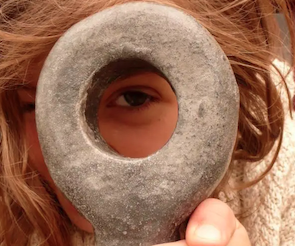For today’s session we visited 2 exhibitions in the Chisenhale gallery & Auto Italia, 2 galleries I haven’t previously been made aware of. The first of the two was Chisenhale, an artist named Claudia Pagès Rabal whom’s piece- ‘Five Defence Towers‘ “intertwines words, bodies, music, and movement. Five Defence Towers marks Pagès’ first institutional solo exhibition in London and the premiere of a major new moving image commission.” “Pagès’ new commission locates five defence towers built throughout Catalonia’s former borderlands.” “These historic frontiers of legal, economic, political, and cultural power struggle are the starting point for Pagès’ new moving image work, which spans scripted dialogue, choreographed dance, light, and sound.”
As you can see from the image below, the film was portrayed through this semi- dome shaped collection of LED screens. Shot on a 360- degree camera, the curation and execution of this artwork was incredibly unique and had a distinct effect on me as a viewer. On each wall was a collection of photos, picturing the remains of the 5 towers. I found these to be very beautiful photos, the colour and actually, darkness of them was what made them most interesting, they weren’t really capturing much, simple pictures of ruins, however she’s managed to embrace and portray her own phycological connection with the issue through these images. I knew nothing about the towers before entering the exhibition, and yet I began to feel as if I had a connection to the them, and the deep emotional presence of the topic became much more prominent.
Claudia Pagès Rabal – Five Defence Towers

Although I did feel massively emotionally connected to Rabal’s film work, I did take a liking to the structuring and arranging of the portrayal of her work. Having worked with film, I have never thought to present it in this kind of way and so this opened my mind up into why and how it has certain effects. Because you’re lying down, looking up to watch the film, you automatically feel in a more vulnerable position, in which you’re almost a subordinate to the film. Without this positioning of the screens, I think the film would have much less of an effect on an audience. The eye contact was a huge part of what made this lay out so interesting, it became very intense at parts with these harsh eyes almost gawking down at you, you’re left with nowhere else to look but directly into her eyes and so you start to feel a relationship form between you and the character.
Nazanin Noori – THE ECHO OF PROTEST IS DISTANT TO THE PROTEST


The other exhibition we went to see was; “THE ECHO OF PROTEST IS DISTANT TO THE PROTEST, the first exhibition in the UK by Berlin-based Iranian interdisciplinary artist Nazanin Noori. The exhibition features newly commissioned works examining the emotional (im)mobilisation of the public in the context of political protest. Created in response to the death of Jina Amini and the uprisings that followed in the Islamic Republic of Iran, the exhibition reflects on the country’s sociopolitical landscape in recent years and explores the complexities of witnessing political events from afar—an experience shaped by paralysis, turmoil and longing.”
The aspect of this work that captured my attention the most was definitely the sound and spatial installation, ‘IF THERE IS GOD NO ONE WILL BE DAMNED / A HOLLOW SONG SUSPENDED‘. An entirely red room with 9 plastic garden chairs placed in a circle, 4 speakers surrounding these chairs playing a 27 minute track composed of ‘electronic textures, orchestral swells and choral fragments’ an incredibly beautiful, layered and developed sound piece. As the redness of the room begins to play with your eyes, the spacial sounds begin to play with your ears, unsure on what quite you’re listening to, you begin to feel quite disoriented and lost within the work. There are these two personas in the piece which are these very powerful choir like singers, and as the piece goes on you’re trying to understand the relationship between them. The piece flows in and out of pockets where it’s as if the voices are trying to fight each other, contrasting and pushing the other, then suddenly they both move into these harmonious sections in which they work together to create an even more powerful sound. This fluctuation is something that really made the piece individual and kept you engaged.
I think overall the biggest impacts these exhibitions had on me, was less so about the artists themselves, but more about curation, spatialisation and the layout of your work. This is something I haven’t really taken into consideration when thinking about displaying my work. When I have done so it’s been in very conventional, normal ways which I can now see how this can have a massive effect on your audience. I am thankful to have been made aware of the importance of this is such a way that I can understand how it has had an effect on myself and therefore am far more conscious of it now.
